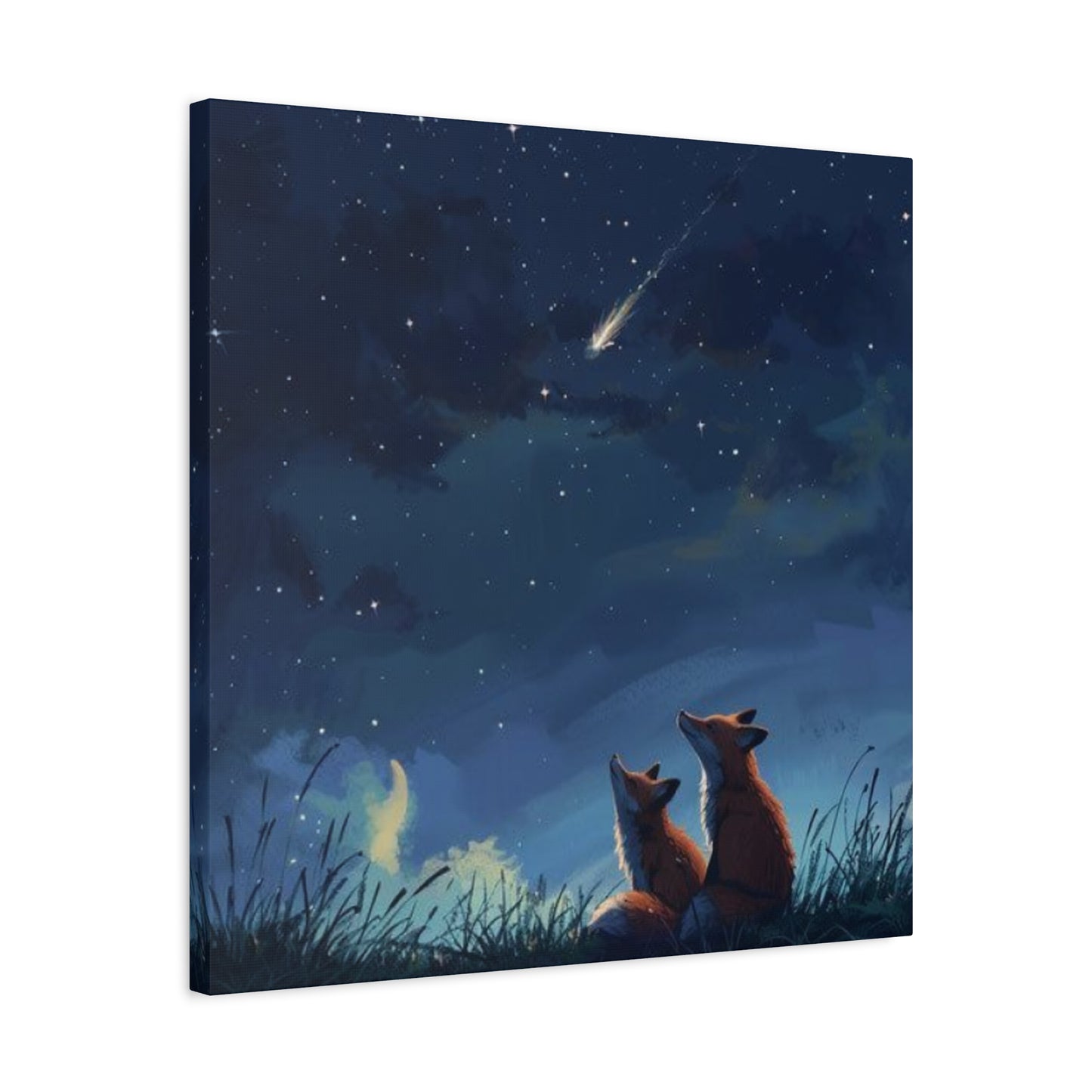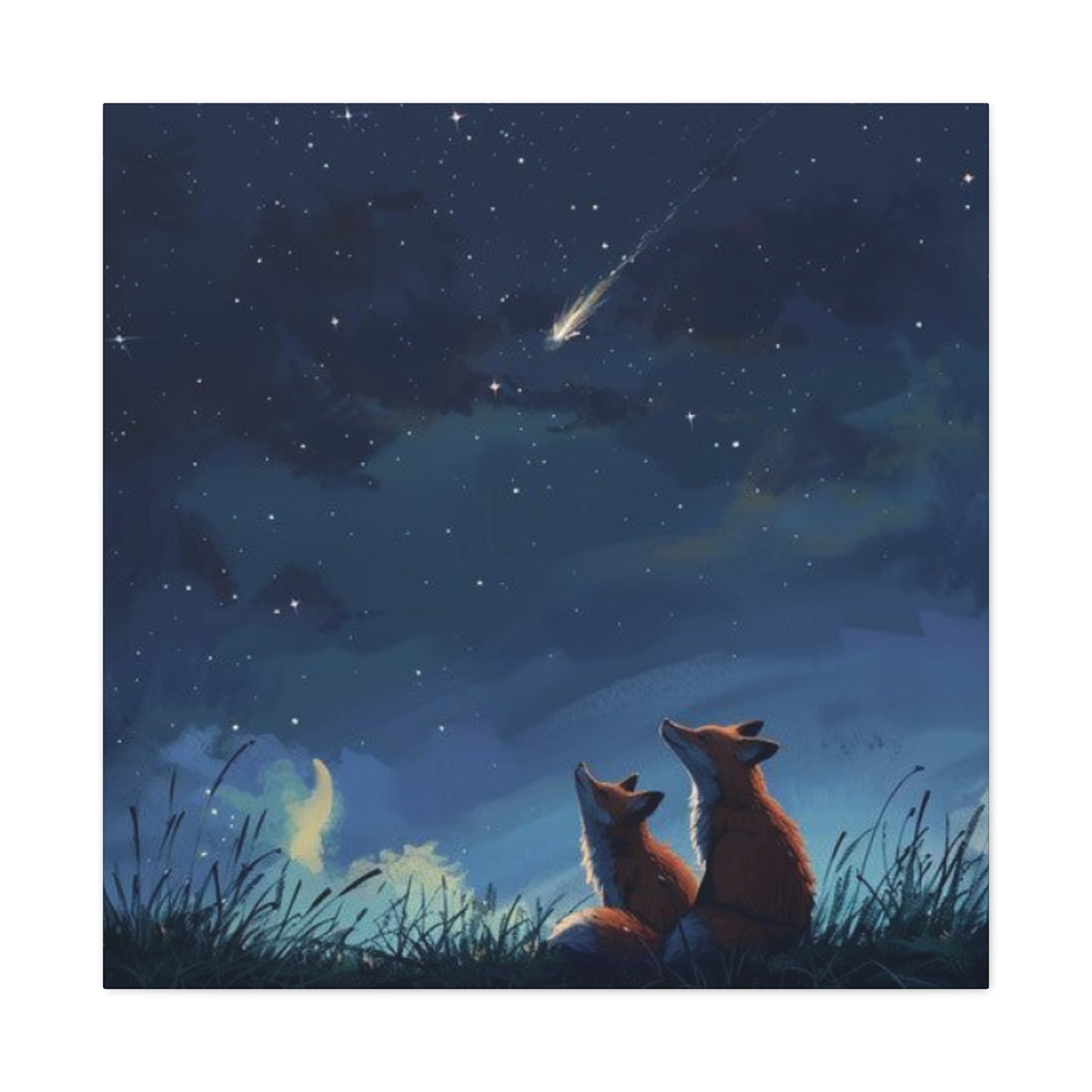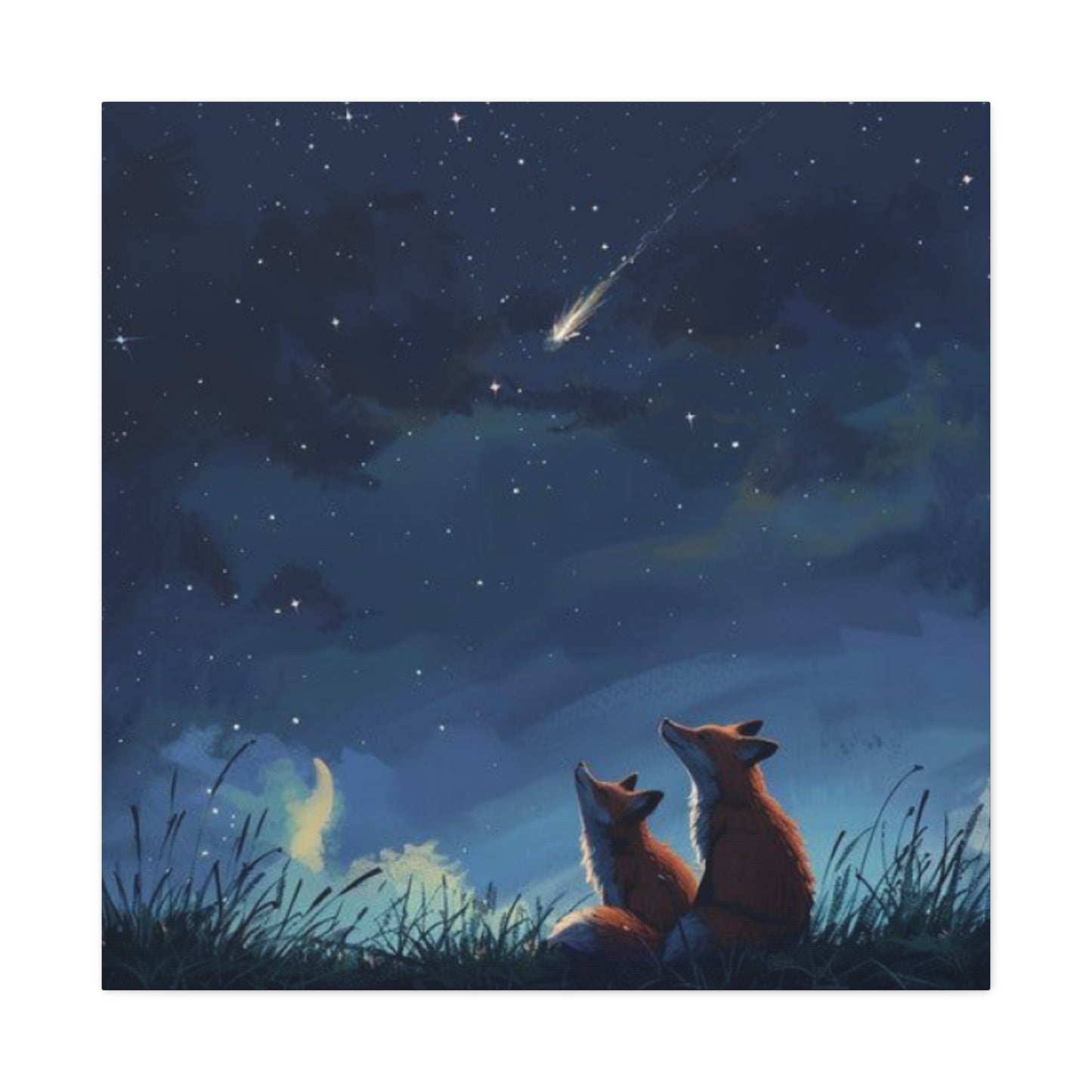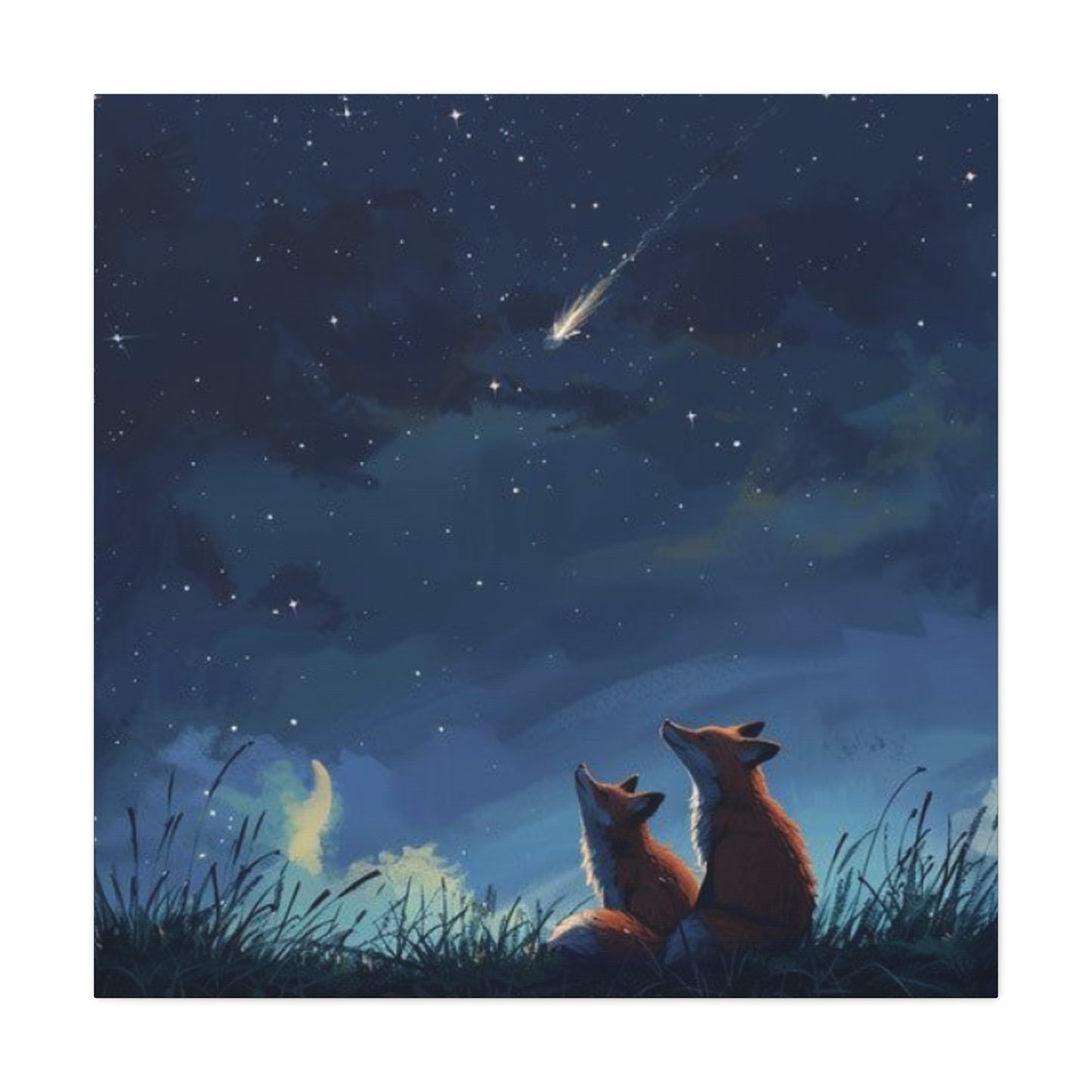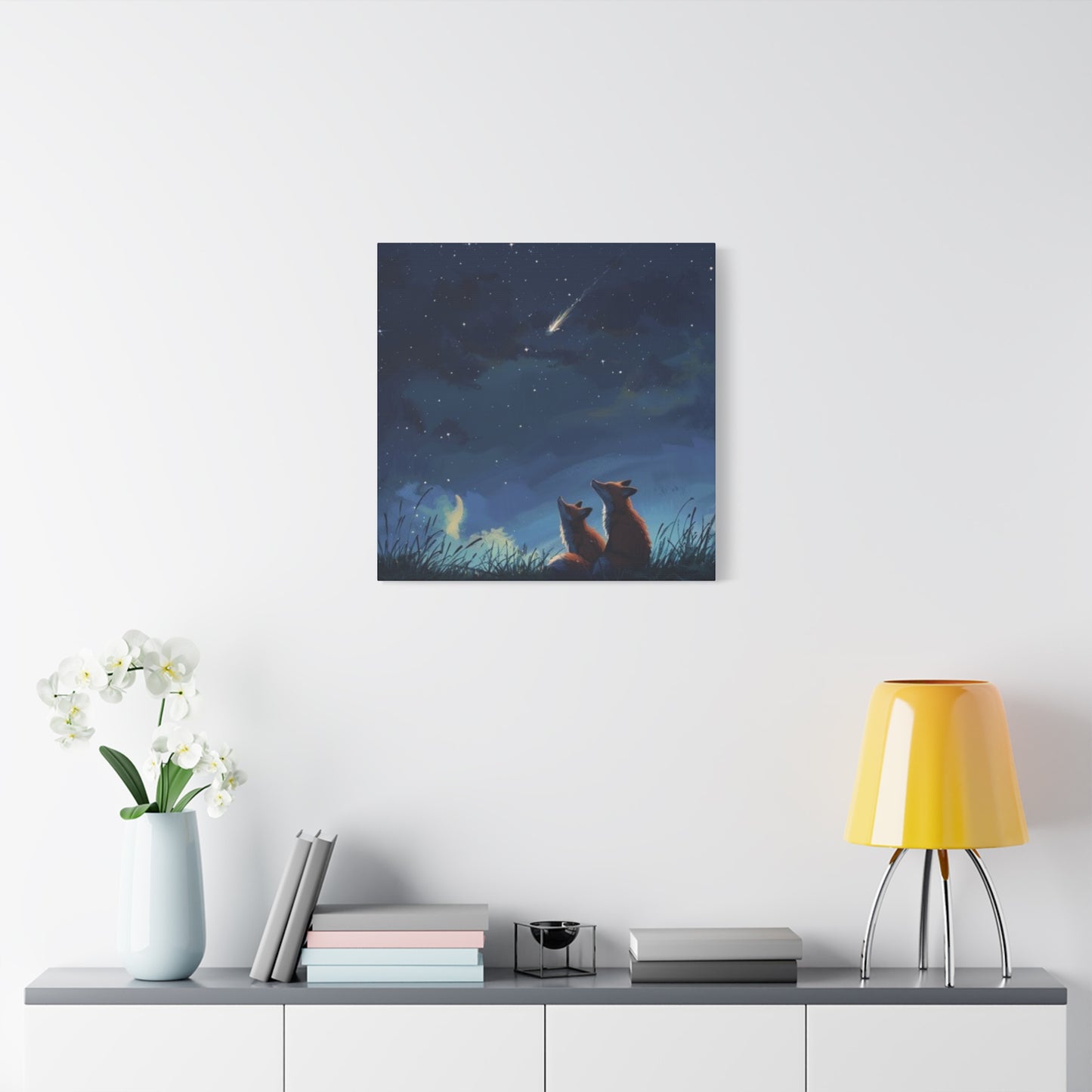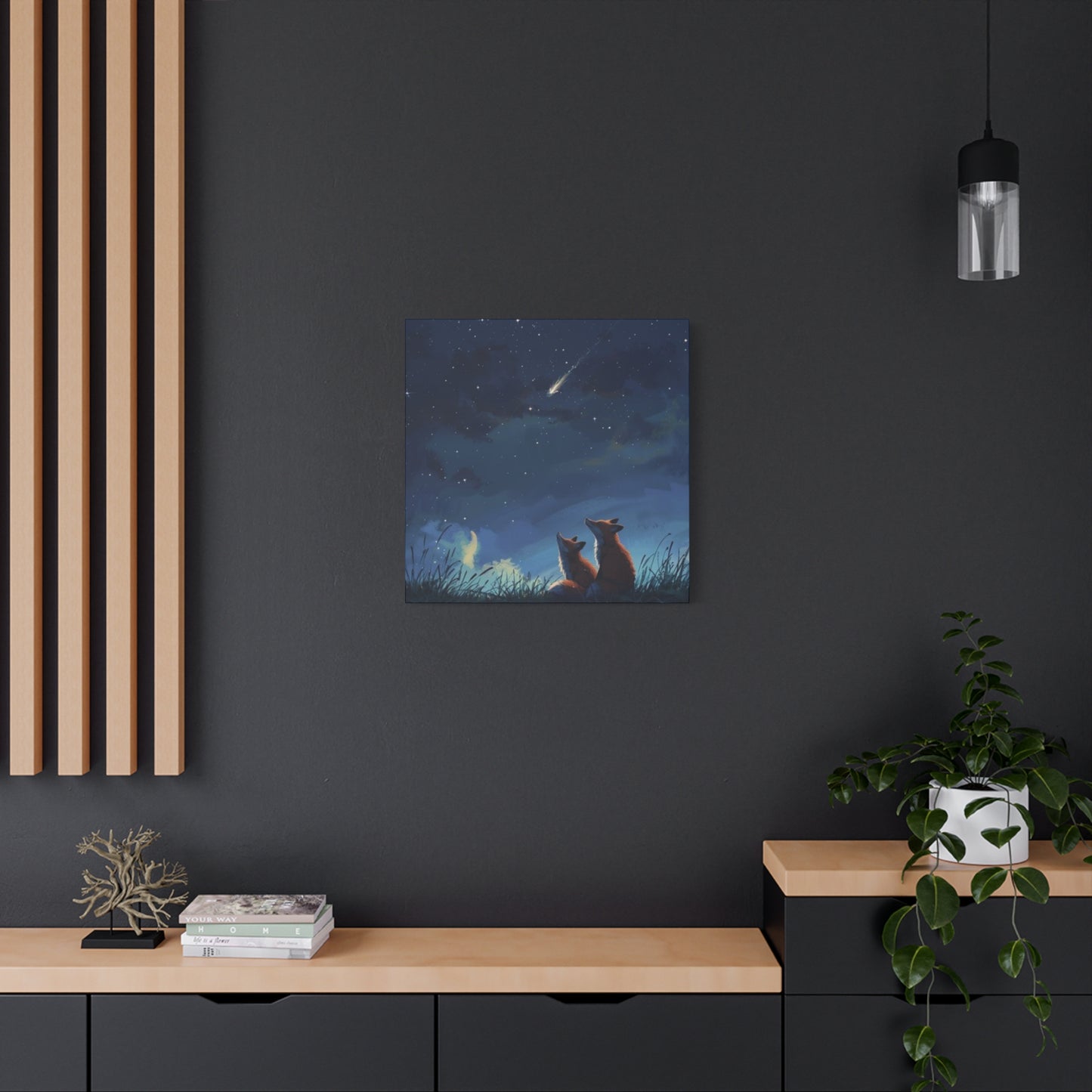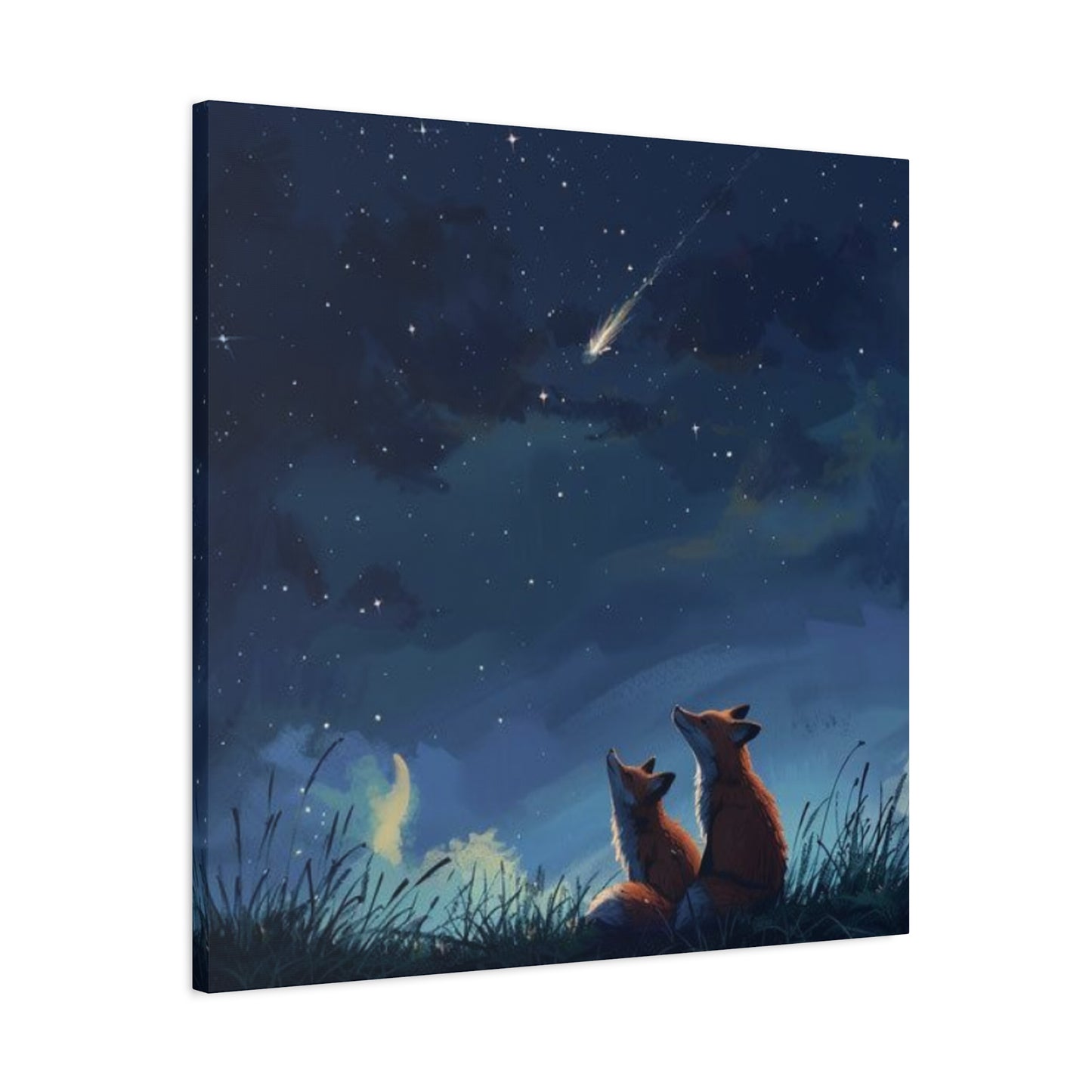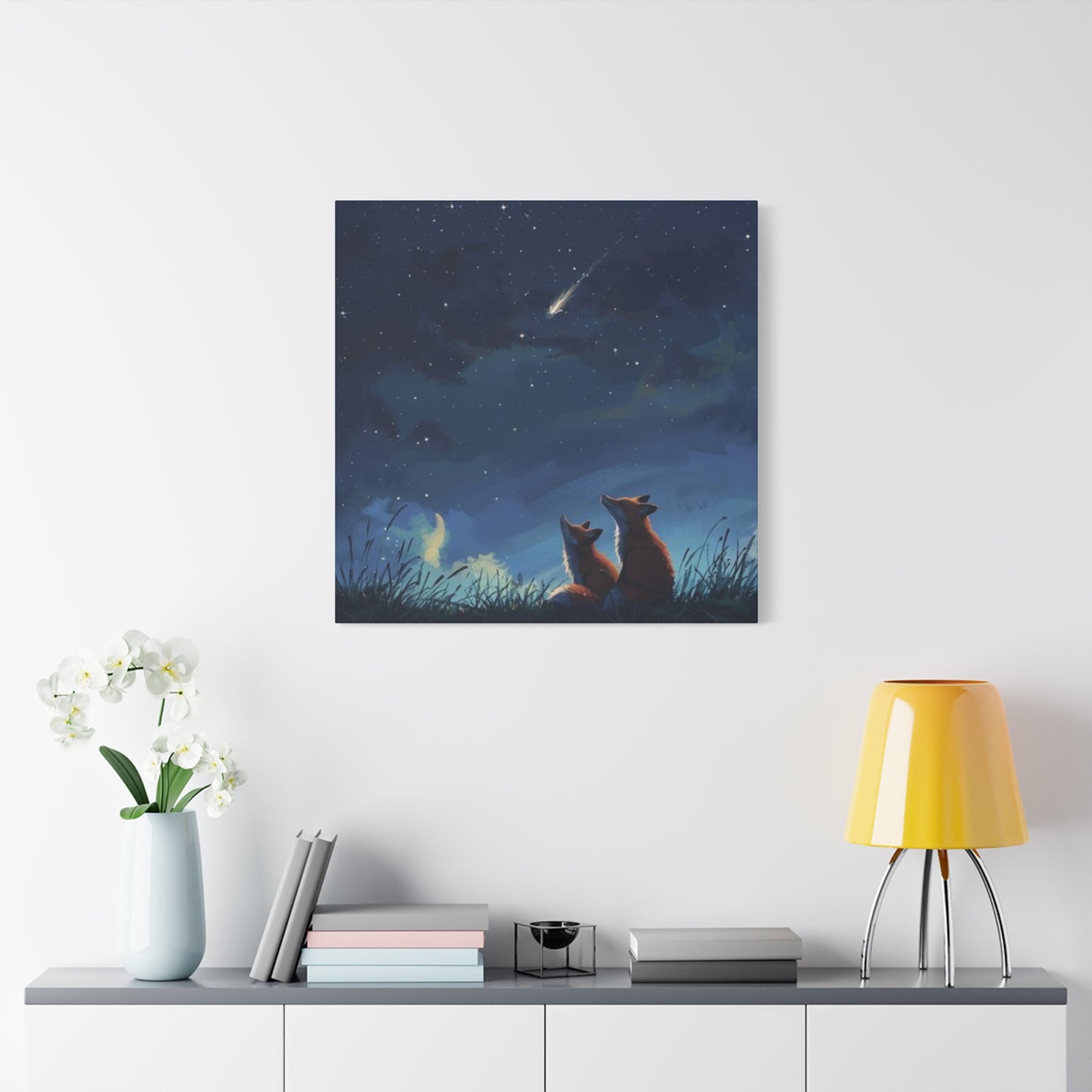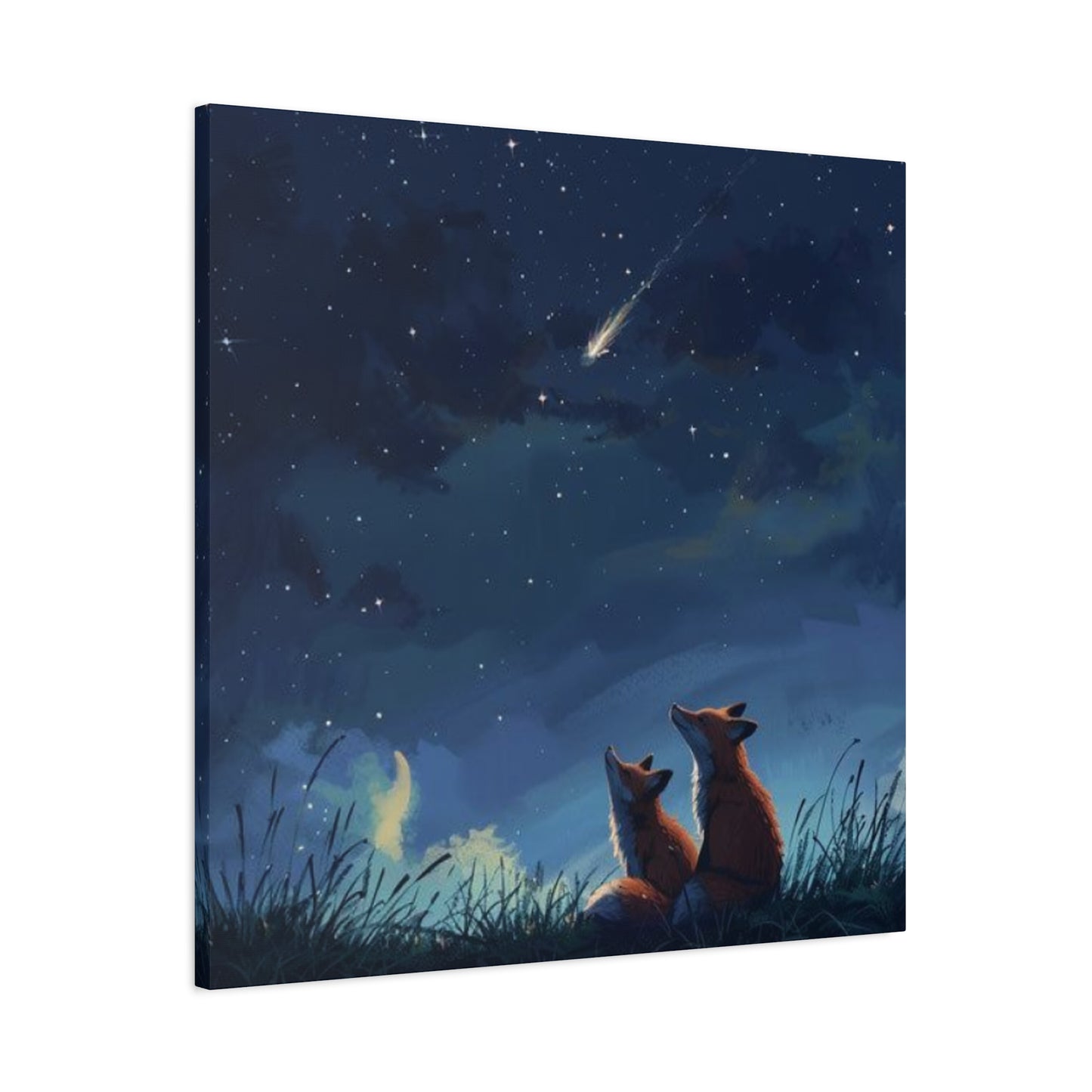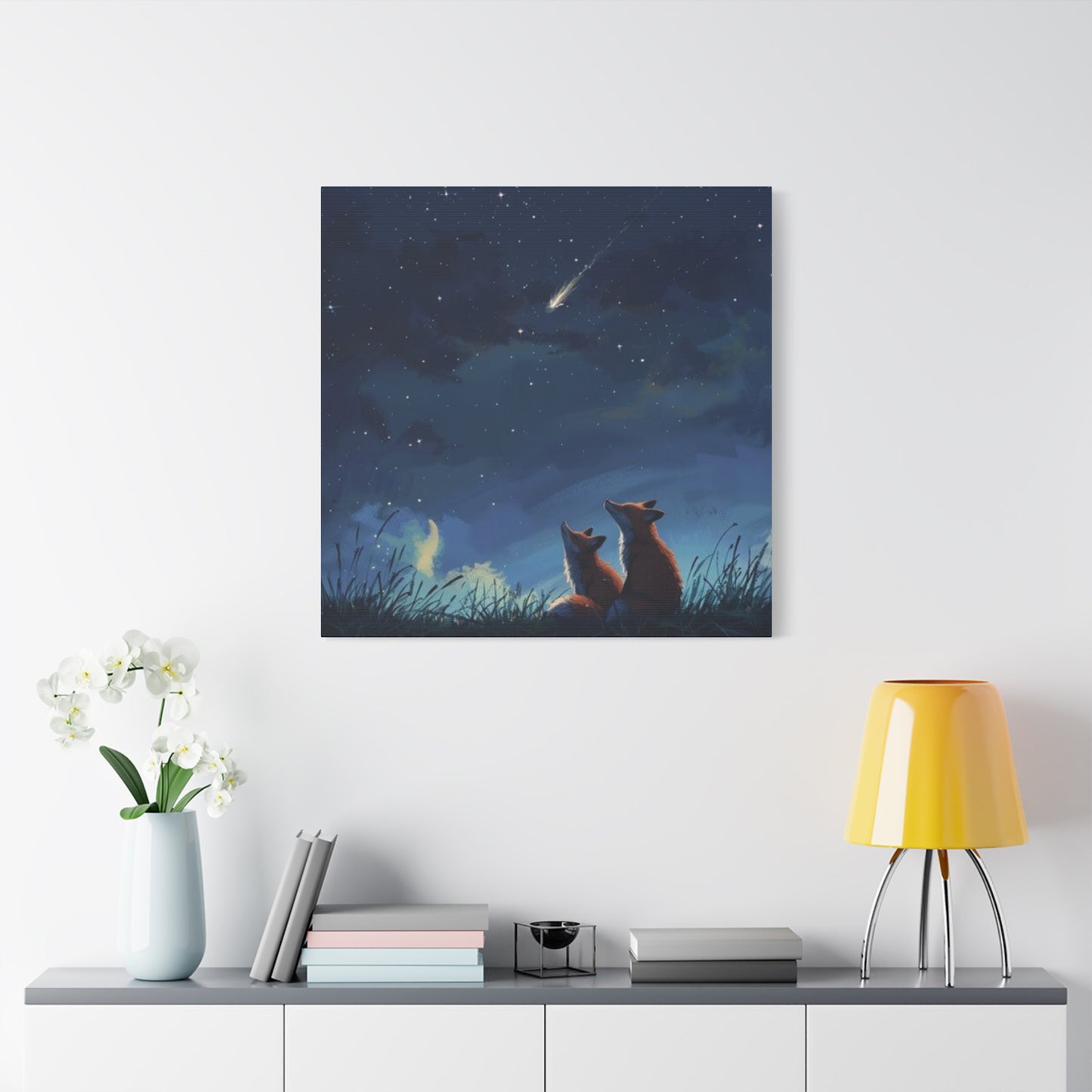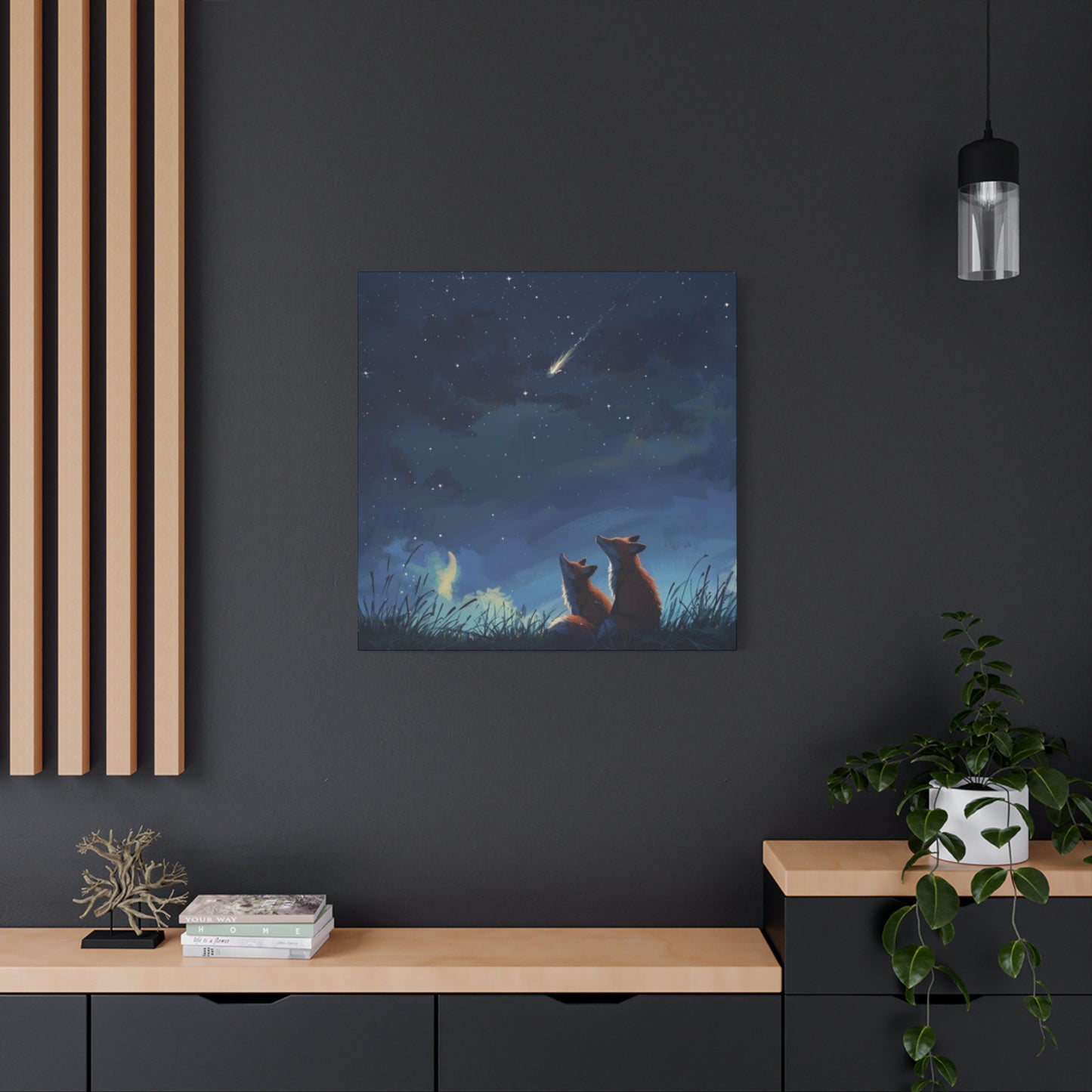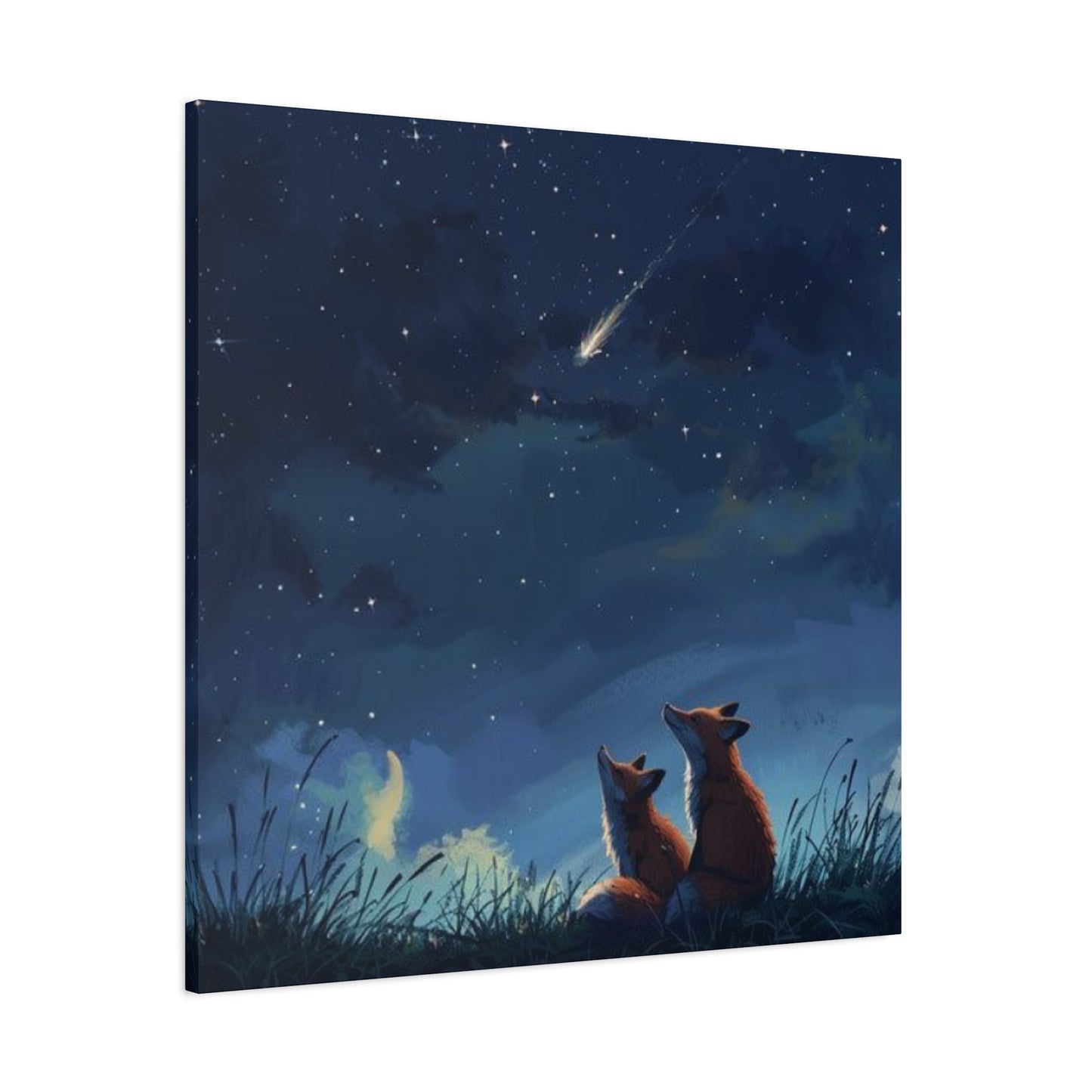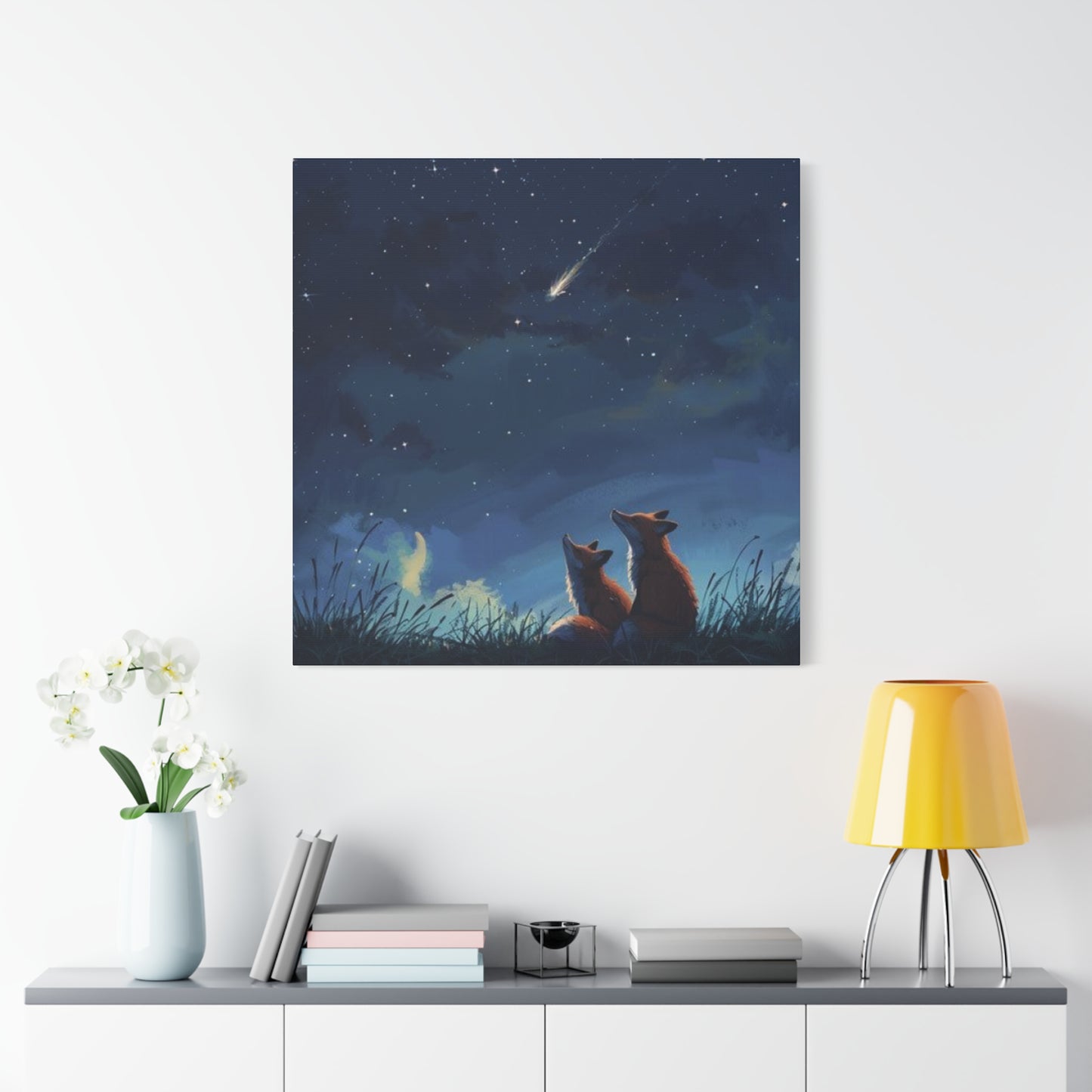Magical Bedroom Decor: Baby Fox at Night Canvas Wall Art
The world of nursery and children's bedroom decoration has evolved dramatically over recent years, with parents increasingly seeking unique, artistic pieces that capture imagination while creating peaceful, nurturing environments. Among the most captivating trends in children's wall art, baby fox nocturnal canvas prints have emerged as a beloved choice, combining the charm of woodland creatures with the serene beauty of nighttime scenes. These enchanting artworks offer more than mere decoration; they serve as windows into magical worlds where gentle forest creatures dance beneath starlit skies, creating atmospheres that inspire dreams and wonder.
The appeal of baby fox nocturnal artwork extends beyond simple aesthetics. These pieces tap into our deep-rooted connection with nature, offering children a sense of comfort and security through familiar yet fantastical imagery. The soft, muted tones typically associated with nighttime forest scenes create calming environments perfect for bedtime routines, while the playful nature of baby foxes adds elements of joy and whimsy that stimulate young imaginations during daytime play.
Charming Baby Fox Evening Canvas Collections
Baby fox evening canvas collections represent a sophisticated approach to children's wall art, moving beyond traditional cartoon imagery to embrace more artistic, nuanced representations of these beloved woodland creatures. These collections typically feature baby foxes in various evening activities, from curling up in cozy dens to exploring moonlit meadows with their families. The artistic quality of these pieces often rivals adult contemporary art, making them suitable for homes where aesthetic consistency throughout all rooms is important.
The beauty of evening canvas collections lies in their ability to tell stories through visual narrative. Each piece within a collection contributes to a larger tale of woodland life, encouraging children to create their own stories about the fox families depicted. This storytelling aspect proves invaluable for cognitive development, as children naturally develop language skills and creative thinking through engagement with narrative artwork.
Professional artists creating these collections often employ various techniques to achieve depth and emotional resonance. Watercolor effects create soft, dreamy backgrounds that seem to glow with inner light, while detailed brush work brings the baby foxes to life with expressive eyes and carefully rendered fur textures. The interplay between realistic anatomical accuracy and artistic interpretation results in foxes that feel both believable and magical, bridging the gap between natural history education and pure artistic enjoyment.
Color palettes in baby fox evening collections tend toward muted earth tones accented with soft blues, purples, and silvery highlights that suggest moonlight filtering through forest canopies. These color choices serve multiple purposes, creating calming environments conducive to rest while maintaining enough visual interest to captivate young viewers during active hours. The sophisticated color work also ensures these pieces age well with children, remaining relevant and appealing as tastes mature.
Many collections feature foxes engaged in activities that mirror human family dynamics, such as parent foxes reading to their kits or entire fox families gathered for evening meals. These familiar scenarios help children connect emotionally with the artwork, seeing reflections of their own family experiences in the forest setting. This emotional connection enhances the artwork's impact, making bedroom spaces feel more personal and meaningful.
The technical execution of these canvas pieces often incorporates multiple printing techniques to achieve museum-quality results. High-resolution digital printing captures every subtle color gradation and fine detail, while archival inks ensure longevity without fading. Many artists also offer hand-embellished versions, where original paint touches are added to printed bases, creating unique pieces that combine affordability with handcrafted authenticity.
Moonlit Woodland Baby Fox Artwork
Moonlit woodland baby fox artwork represents perhaps the most romantic and dreamy category within this artistic niche. These pieces capitalize on the inherent magic of moonlight, using its soft, ethereal glow to create scenes that feel otherworldly yet intimately familiar. The moon serves as both a light source and a focal point, often depicted in various phases to add astronomical education to artistic beauty.
Artists working in this style frequently employ techniques that make moonlight appear to actually illuminate their canvases. Careful gradations of light and shadow create convincing three-dimensional effects, while strategic placement of highlights on fox fur and surrounding foliage suggests authentic lunar illumination. This technical mastery transforms flat canvas surfaces into windows onto moonlit forest worlds.
The emotional impact of moonlit scenes cannot be overstated. Moonlight has long been associated with dreams, magic, and peaceful contemplation across human cultures. When combined with the innocent charm of baby foxes, these associations create powerful emotional responses that make bedrooms feel like sanctuaries. Children often report feeling protected and comforted by moonlit fox artwork, as if the gentle creatures are standing guard through the night.
Compositional elements in moonlit woodland scenes typically include various forest features that enhance the sense of being deep within natural settings. Ancient trees with gnarled branches frame scenes, their leaves catching moonlight to create patterns of light and shadow. Forest floors carpeted with moss and fallen leaves provide soft surfaces for baby foxes to explore, while distant mountains or clearings suggest vast wilderness beyond the immediate scene.
The educational value of moonlit woodland artwork extends to teaching children about nocturnal wildlife behavior. Many pieces accurately depict the natural activities of foxes during nighttime hours, showing them hunting, playing, or traveling between den sites. This scientific accuracy, woven into artistic presentation, helps children develop understanding of natural cycles and animal behavior patterns.
Seasonal variations within moonlit woodland themes offer opportunities to change artwork throughout the year, maintaining visual interest while teaching about natural cycles. Spring scenes might feature baby foxes discovering their first flowers under April moonlight, while autumn pieces could show families preparing dens amid colorful fallen leaves illuminated by harvest moons. These seasonal collections help children connect artwork to their own experiences of changing seasons.
The therapeutic qualities of moonlit woodland scenes have been recognized by child psychologists and interior designers specializing in children's spaces. The combination of natural imagery, soft lighting effects, and peaceful animal subjects creates environments that naturally reduce stress and anxiety. Many parents report improved sleep patterns in children after installing moonlit fox artwork in bedrooms.
Whimsical Starlit Baby Fox Prints
Whimsical starlit baby fox prints take nocturnal forest art into realms of pure fantasy and imagination. These pieces often feature baby foxes interacting with stars as if they were tangible objects, catching them in paws or using them as stepping stones across night skies. The whimsical approach allows artists greater creative freedom, resulting in artwork that prioritizes emotional impact and imaginative stimulation over realistic representation.
The stars themselves become characters in these whimsical interpretations, often depicted with faces, personalities, or magical properties. Some pieces show baby foxes dancing with anthropomorphized stars, while others feature constellations that form shapes meaningful to the fox families below. This personification of celestial objects helps children develop emotional connections to astronomy, potentially fostering lifelong interests in space science.
Color palettes in whimsical starlit prints often venture beyond naturalistic earth tones to include magical purples, deep teals, and shimmering golds that suggest otherworldly atmospheres. These bold color choices create visual excitement while maintaining the calming overall effect essential for bedroom artwork. The contrast between realistic fox anatomy and fantastical backgrounds creates visual tension that keeps viewers engaged.
Interactive elements frequently appear in whimsical starlit designs, encouraging children to discover hidden details with repeated viewing. Stars might form patterns that spell out words or create pictures when connected with imaginary lines. Baby foxes might be positioned to suggest movement or dance, with flowing tails and outstretched paws creating dynamic compositions that seem to move with changing light conditions in rooms.
The storytelling potential of whimsical starlit prints exceeds even that of more realistic pieces. The fantasy elements provide jumping-off points for elaborate bedtime stories, with children often requesting tales about specific foxes or stars depicted in their room artwork. Parents frequently report that these prints serve as invaluable aids for creative storytelling sessions that strengthen family bonds while developing children's imagination and language skills.
Technical execution of whimsical pieces often involves layering techniques that create depth and luminosity. Background skies might be created with airbrushing or digital gradients, while stars are added in successive layers to achieve convincing glow effects. Baby foxes are typically rendered with careful attention to texture and expression, ensuring they remain relatable and appealing despite their fantastical surroundings.
The psychological benefits of whimsical starlit artwork relate to its ability to normalize imagination and creativity. Children surrounded by art that celebrates fantasy and creative interpretation receive implicit messages that their own imaginative thoughts are valuable and normal. This validation of creativity can contribute to confident self-expression and innovative thinking patterns that benefit academic and social development.
Adorable Nighttime Fox Bedroom Decor
Creating cohesive bedroom environments around adorable nighttime fox themes requires careful consideration of how individual art pieces work together with other decorative elements. The most successful fox-themed bedrooms achieve balance between thematic consistency and visual variety, ensuring spaces feel purposefully designed rather than cluttered with similar imagery.
Bedroom decor centered around nighttime fox themes typically begins with a primary artwork piece that establishes the room's emotional tone and color palette. This anchor piece, often a large canvas or set of coordinated prints, provides the foundation from which other decorative decisions flow. Smaller complementary pieces can then be selected to reinforce the theme without overwhelming the space or competing for attention.
Lighting plays a crucial role in nighttime fox bedroom decor, both in illuminating the artwork effectively and in creating atmospheric conditions that complement the nocturnal theme. Soft, warm lighting sources such as table lamps with fabric shades or string lights with warm-white bulbs echo the gentle moonlight depicted in fox artwork. Avoid harsh overhead fluorescent lighting that can wash out subtle color variations in prints.
Textile selections offer opportunities to extend fox themes throughout bedroom spaces without relying solely on wall art. Bedding featuring subtle woodland patterns or solid colors that echo artwork palettes helps create visual cohesion. Throw pillows with fox motifs can add playful touches without dominating the space, while curtains in complementary colors frame windows and tie room elements together.
Furniture choices should support the natural, woodland aesthetic without competing with fox artwork for attention. Natural wood finishes, particularly in lighter oak or birch tones, complement the forest themes while providing practical storage and surface space. Avoid overly ornate or brightly colored furniture pieces that might clash with the subtle sophistication of quality fox artwork.
Storage solutions can be integrated into fox-themed decor through creative selection of containers and organizers. Wicker baskets suggest natural materials found in forest settings, while wooden toy boxes can be selected or painted to coordinate with artwork frames. These functional elements contribute to the overall theme while serving essential organizational purposes in children's rooms.
The scale and placement of fox artwork within bedroom spaces requires careful planning to achieve maximum impact without overwhelming young occupants. Large pieces work well as focal points above beds or dressers, while smaller prints can create gallery walls or fill awkward spaces near doorways or in corners. Consider children's eye levels when hanging artwork to ensure they can easily view and enjoy the pieces from their natural vantage points within rooms.
Seasonal adaptability in fox-themed bedroom decor allows for refreshing changes that maintain interest throughout the year. Lightweight textile elements such as throw pillows or small decorative objects can be swapped seasonally to echo the changing forest scenes depicted in permanent artwork. This approach keeps rooms feeling fresh and connected to natural cycles without requiring major redecoration efforts.
Baby Fox Shadow Art at Twilight
Baby fox shadow art at twilight represents a sophisticated artistic approach that emphasizes form and emotion over detailed realistic rendering. These pieces capture the magical moments when daylight fades into darkness, creating atmospheric conditions where shadows become as important as the subjects themselves. The interplay between light and shadow adds dramatic depth to artwork while maintaining the gentle appeal essential for children's bedroom decor.
Twilight scenes offer unique color opportunities, as this transitional time of day features some of nature's most spectacular color displays. Deep purples and roses in twilight skies provide rich backdrops for fox silhouettes, while the last rays of sunlight create rim-lighting effects that define animal forms without revealing every detail. This selective revelation allows viewers' imaginations to complete the scenes, creating more engaging and personally meaningful artwork.
The artistic technique of working with shadows requires exceptional skill in understanding how light behaves in natural settings. Artists must carefully observe how twilight conditions affect the appearance of fox fur, facial features, and body proportions to create convincing shadow representations. The most successful pieces maintain enough detail to clearly identify the subjects as baby foxes while preserving the mystery and elegance that shadow art provides.
Emotional resonance in twilight shadow art often exceeds that of fully detailed pieces because shadows tap into psychological associations with mystery, dreams, and the transition into sleep. Children often find shadow art particularly compelling because it mirrors their own experience of watching familiar objects transform into mysterious shapes as bedtime approaches. This psychological connection makes twilight fox shadows especially appropriate for bedroom environments.
Compositional elements in shadow art require careful balance to maintain visual interest without the benefit of detailed textures and colors. Artists often rely on strong silhouette shapes, interesting negative space patterns, and strategic placement of lighter elements such as stars or moon crescents to create dynamic compositions. The challenge lies in conveying personality and emotion through simplified forms.
The educational aspect of shadow art provides opportunities to teach children about the science of light and shadow while developing their observational skills. Parents can use twilight fox artwork as starting points for discussions about how shadows form, why they change throughout the day, and how animals adapt their behavior to different lighting conditions. These scientific concepts become more accessible and memorable when connected to appealing artwork.
Technical execution of shadow art often involves multiple layers of transparent glazes or digital techniques that build depth through subtle value changes. Even within shadow areas, skilled artists create variations in darkness that suggest form and dimension. This technical sophistication ensures that shadow art maintains visual interest during extended viewing while preserving the simplified elegance that defines the style.
The versatility of shadow art makes it particularly suitable for rooms where other family members might also spend time, such as nurseries shared with older siblings or guest rooms that occasionally house children. The sophisticated aesthetic appeals to adult sensibilities while remaining completely appropriate and engaging for young viewers.
Mystical Baby Fox Evening Canvas Art
Mystical baby fox evening canvas art ventures into realms where reality blends with fantasy, creating scenes that suggest magical properties within ordinary forest settings. These pieces often feature elements that hint at supernatural or enchanted qualities without becoming overtly fantastical, maintaining believability while sparking imagination. The mystical approach allows artists to create deeply atmospheric pieces that seem to hold secrets and stories within their imagery.
Evening settings provide perfect backdrops for mystical interpretations, as the natural magic of dusk creates conditions where extraordinary events seem possible. Mist rising from forest floors, unusual cloud formations, or unexplained light sources can be incorporated naturally into evening scenes, adding mystical qualities without requiring obviously supernatural elements. This subtle approach to fantasy makes artwork more broadly appealing and timelessly relevant.
The baby foxes in mystical evening art often display slightly unusual behaviors or appear in improbable situations that suggest special qualities without clearly defining them. A fox kit might be shown apparently communicating with fireflies, or positioned as if listening to sounds inaudible to human ears. These subtle suggestions of otherworldly awareness invite viewers to imagine expanded stories about the fox characters.
Color work in mystical evening pieces frequently employs unexpected hues that suggest otherworldly atmospheres while remaining pleasing to view. Deep indigos might be touched with unusual greens, or earth tones might be infused with subtle purples that seem to glow from within. These color choices create visual intrigue while maintaining the harmonious palettes essential for successful bedroom artwork.
Lighting effects in mystical art often feature unexplained illumination that adds to the sense of magic without requiring obvious supernatural sources. Foxes might appear to be lit by mysterious glows, or certain areas of forest scenes might be illuminated more brightly than natural light sources would suggest. These lighting anomalies create focal points and add visual drama while maintaining artistic credibility.
The psychological appeal of mystical art relates to children's natural inclination toward magical thinking and their comfort with blurred boundaries between reality and fantasy. Young minds easily accept the possibility that forest animals might possess special abilities or that evening hours might bring unusual events. This acceptance makes mystical fox art particularly resonant for children's spaces.
Symbolic elements often appear in mystical evening fox art, providing layers of meaning that can be discovered and discussed as children mature. Ancient tree symbols, particular flower types, or unusual rock formations might carry traditional meanings that enrich the artwork's educational value. These symbolic elements reward repeated viewing and provide topics for ongoing conversations between parents and children.
The craftsmanship required for successful mystical art demands exceptional technical skill combined with sophisticated understanding of psychological impact. Artists must balance mysterious elements with clear storytelling, creating pieces that intrigue without confusing young viewers. This balance requires careful attention to composition, color relationships, and the subtle details that suggest magic without explicitly depicting it.
Sleepy Baby Foxes Under Starlight
Artwork featuring sleepy baby foxes under starlight taps into one of the most fundamental human experiences: the transition from wakefulness to sleep. These pieces typically depict fox kits in various stages of drowsiness, from yawning cubs to families curled together in peaceful slumber beneath star-filled skies. The imagery naturally promotes calm, restful feelings that make such artwork ideal for bedroom environments where peaceful sleep is the ultimate goal.
The artistic challenge in depicting sleepy animals lies in capturing the subtle physical changes that occur as creatures prepare for rest. Artists must understand how fox anatomy changes as muscles relax, how eyes appear when heavy with sleep, and how family groups arrange themselves for comfort and warmth. This attention to biological accuracy ensures that the depicted rest appears natural and convincing.
Starlight provides perfect illumination for sleepy fox scenes, offering enough light to reveal important details while maintaining the dim conditions appropriate for bedtime. Artists often use starlight to create gentle highlighting effects on fox fur, suggesting the soft touch of celestial illumination without harsh contrasts that might feel energizing rather than calming. The stars themselves often appear as soft points of light rather than sharp, bright objects.
The emotional resonance of sleepy fox imagery extends beyond simple identification with tired animals. Children often see reflections of their own bedtime experiences in family groups of foxes settling down for the night. Parent foxes watching over sleeping kits mirror the protective presence of human parents, while the cozy den settings suggest the security and comfort of well-prepared sleeping spaces.
Composition in sleepy fox artwork typically emphasizes horizontal lines and stable, grounded forms that psychologically suggest rest and stability. Curved lines follow the natural shapes of sleeping animals, while diagonal elements are minimized to avoid suggesting movement or activity. Background elements such as gently rolling hills or horizontal cloud formations reinforce the peaceful, restful atmosphere.
Color palettes for sleepy fox art lean heavily toward cool, muted tones that psychologically promote relaxation. Deep blues and purples dominate night skies, while fox fur is often rendered in warm but subdued earth tones that suggest the natural color changes that occur in dim light. Accent colors, when used, tend toward soft lavenders or pale yellows that suggest gentle starlight or distant dawn.
The educational component of sleepy fox artwork can include accurate information about how wild animals prepare for sleep, their natural sleep cycles, and the importance of rest for healthy development. Children can learn about den construction, family sleeping arrangements in the wild, and the ways different animals adapt to nighttime conditions. These scientific elements add depth to artistic appreciation.
Technical execution of sleepy fox art often requires subtle techniques that suggest softness and tranquility. Soft brush techniques or digital effects that blur harsh edges create impressions of gentle movement and relaxed forms. Color blending techniques ensure smooth transitions that avoid jarring contrasts, while careful attention to light direction creates believable illumination effects that enhance rather than distract from the peaceful mood.
Watercolor Baby Fox Night Artwork
Watercolor baby fox night artwork represents one of the most emotionally evocative approaches to this subject matter, utilizing the medium's inherent softness and luminosity to create dreamlike scenes that seem to glow with inner light. The watercolor technique's characteristic bleeding and flowing effects naturally complement nighttime themes, suggesting the fluid boundaries between day and night, consciousness and dreams, reality and imagination.
The technical demands of watercolor painting require artists to work quickly and confidently, as the medium does not easily allow for corrections or overwork. This immediacy often results in fresh, spontaneous-feeling artwork that captures the essence of nocturnal fox behavior with energetic brushstrokes and confident color application. The transparency of watercolor allows for complex layering effects that create atmospheric depth difficult to achieve with opaque media.
Color relationships in watercolor night scenes benefit from the medium's natural luminosity and its ability to create subtle gradations between related hues. Night skies rendered in watercolor can display complex color relationships as different pigments interact on wet paper, creating sky effects that appear to move and shift with changing viewing angles. This natural variation adds life and movement to static artwork.
The paper texture in watercolor work contributes significantly to the final artwork's character, with different paper surfaces creating various effects that can enhance fox fur textures or sky atmospheres. Hot-pressed papers create smooth, even washes ideal for clear night skies, while cold-pressed papers with more texture can suggest the rough surfaces of tree bark or the soft irregularities of animal fur.
Wet-into-wet techniques, where wet paint is applied to damp paper or into other wet paint areas, create the soft, diffused effects that make watercolor particularly suitable for night scenes. These techniques can suggest mist rising from forest floors, the soft edges of clouds against night skies, or the gentle transitions between light and shadow on fox fur. The unpredictable nature of these effects adds spontaneity and life to finished pieces.
The emotional appeal of watercolor baby fox night artwork relates to the medium's association with childhood art experiences and its gentle, non-threatening appearance. Even when depicting wild animals, watercolor techniques soften edges and mute harsh contrasts, creating imagery that feels safe and nurturing. This emotional safety makes watercolor fox art particularly appropriate for young children's spaces.
Preservation considerations for watercolor artwork require attention to UV protection and humidity control, as the medium's pigments can be sensitive to environmental conditions. High-quality archival papers and lightfast pigments ensure longevity, while proper framing with UV-filtering glass protects against fading. These technical considerations ensure that watercolor fox artwork remains beautiful throughout years of enjoyment.
The teaching potential of watercolor fox artwork extends to encouraging children's own artistic exploration, as watercolor techniques are accessible to young artists while offering endless possibilities for experimentation and growth. Parents can use professional watercolor fox art as inspiration for family art projects, creating connections between appreciation of fine art and personal creative expression.
Cartoon Baby Fox Night Sky Art
Cartoon baby fox night sky art brings playful, child-friendly interpretation to nocturnal wildlife themes, emphasizing entertainment and emotional connection over realistic representation. These pieces typically feature foxes with exaggerated cute features, expressive faces, and human-like behaviors that make them immediately appealing to young viewers. The cartoon approach allows for greater creative freedom in depicting impossible or fantastical scenarios while maintaining clear storytelling elements.
Character development in cartoon fox art often involves giving individual foxes distinct personalities expressed through facial expressions, body language, and positioning within scenes. One fox might be depicted as curious and adventurous, while another appears shy and contemplative. These personality differences encourage children to develop emotional attachments to specific characters and create ongoing narratives about their adventures.
The night sky environments in cartoon fox art frequently feature anthropomorphized elements such as smiling moons, winking stars, or clouds with facial expressions. These personified environmental elements create more interactive, engaging scenes where every component of the artwork contributes to storytelling potential. Children often find these animated environments more approachable than realistic depictions of natural settings.
Color palettes in cartoon night sky art tend toward brighter, more saturated hues than realistic nocturnal scenes, ensuring visual appeal and energy appropriate for children's spaces. While maintaining nighttime themes, cartoon artists often use purple skies, bright yellow moons, and colorful stars that create cheerful rather than mysterious atmospheres. These color choices support positive associations with bedtime and nighttime hours.
The artistic techniques used in cartoon fox art emphasize clear outlines, simplified forms, and bold color areas that read clearly from various viewing distances. This clarity ensures that artwork remains visually interesting whether viewed up close during quiet activities or from across rooms during active play. The simplified forms also make characters easily recognizable and memorable for young children.
Educational elements in cartoon fox art can include basic information about fox behavior, forest environments, and nighttime natural phenomena presented in age-appropriate, entertaining ways. Cartoon foxes might be shown learning about constellations, discovering nocturnal insects, or participating in forest adventures that subtly teach about natural ecosystems and animal behavior patterns.
The emotional safety provided by cartoon fox art makes it particularly suitable for children who might find realistic wildlife art intimidating or overstimulating. The clearly artificial, friendly appearance of cartoon foxes removes any possibility of fear while maintaining the positive associations with nature and outdoor adventure. This emotional comfort allows children to enjoy wildlife themes without anxiety.
Technical execution of cartoon night sky art often involves bold, confident line work combined with flat or simply shaded color areas that create clean, graphic appearances. Digital techniques frequently allow for precise color control and easy revision of character expressions or positioning. The technical simplicity of cartoon approaches makes this style accessible to a broader range of artists while maintaining professional quality results.
Fox Family Evening Wall Art
Fox family evening wall art focuses on the social dynamics and emotional bonds within fox family units, creating artwork that celebrates family relationships while showcasing these beautiful animals in their natural evening activities. These pieces often depict multiple generations of foxes engaged in typical family behaviors such as grooming, playing, teaching, or simply resting together as day transitions into night.
The family dynamics portrayed in these artworks provide children with relatable scenarios that mirror their own family experiences while introducing them to natural animal behavior patterns. Parent foxes might be shown teaching kits important survival skills, siblings playing together, or entire family groups gathering for evening meals. These familiar relationship dynamics help children connect emotionally with the wildlife subjects while learning about animal social structures.
Compositional arrangements in fox family art typically emphasize grouping and connection between family members through positioning, eye contact, and physical proximity. Artists carefully arrange multiple subjects to create visual flow that guides viewers' eyes throughout the composition while maintaining focus on the relationships between characters. The challenge lies in balancing individual character development with cohesive group dynamics.
The evening setting provides natural opportunities to show family protective behaviors, as this transitional time often sees parent animals gathering their young for safety during nighttime hours. These protective scenes reassure children about their own family security while teaching about natural animal instincts and behaviors. The evening timeline also allows for depicting the cozy, settling-in activities that parallel human family bedtime routines.
Age progression within fox families offers educational opportunities to show how young animals grow and develop within their family units. Artwork might feature kits of different ages, from tiny newborns to nearly adult young foxes, demonstrating the continuous nature of family bonds and growth. These age variations also provide visual interest and storytelling possibilities within single pieces.
The artistic challenges of depicting multiple animal subjects require exceptional skill in character differentiation and spatial organization. Each family member must remain individually identifiable and appealing while contributing to the overall composition's success. Artists must also manage complex lighting scenarios where multiple subjects interact with evening light sources in believable ways.
Color coordination across multiple fox subjects requires careful planning to maintain visual unity while allowing for individual character differences. Subtle variations in fur color and marking patterns help distinguish family members while maintaining the natural color relationships that identify them as related individuals. Background colors must complement multiple foreground subjects without overwhelming the composition.
The long-term appeal of fox family artwork lies in its ability to grow with children, offering new details and relationship dynamics to discover as observational skills develop. Young children might initially focus on the cute baby foxes, while older children begin to notice the complex interactions and behaviors depicted throughout the family group. This layered complexity ensures lasting engagement and value.
Starlit Night Baby Fox Illustrations
Starlit night baby fox illustrations represent a perfect fusion of astronomical wonder and wildlife appreciation, creating artwork that encourages interest in both natural science and artistic beauty. These pieces typically feature baby foxes positioned beneath spectacular star displays, often with recognizable constellation patterns or dramatic celestial events such as meteor showers providing stunning backdrops for intimate animal scenes.
The astronomical accuracy in quality starlit fox illustrations adds educational value while maintaining artistic beauty. Artists often research actual constellation patterns, seasonal star positions, and celestial phenomena to create scientifically credible night skies that can serve as informal astronomy lessons. Children can learn to identify real constellation patterns while enjoying appealing fox characters in the foreground.
Star rendering techniques vary dramatically between artists, with some preferring realistic point-of-light stars while others create stylized, decorative stellar displays that emphasize artistic impact over scientific accuracy. Both approaches have merit, with realistic stars supporting educational goals while decorative stars enhance visual appeal and artistic cohesion. The choice often depends on the overall artistic vision and intended audience.
The scale relationships between terrestrial fox subjects and celestial backgrounds require careful handling to maintain believable proportions while creating visually compelling compositions. Baby foxes must appear appropriately sized relative to their forest environments while the vast scale of starry skies is suggested without overwhelming the intimate animal subjects. This balance ensures that both elements contribute effectively to the overall artwork.
Seasonal considerations in starlit fox illustrations can reflect the changing night sky throughout the year, offering opportunities to create series that teach about astronomical cycles while following fox families through different seasons. Spring illustrations might feature baby foxes born under different constellation patterns than autumn pieces, creating educational connections between animal life cycles and celestial events.
The technical challenges of rendering convincing starlight effects require understanding of how celestial illumination appears in natural settings. Unlike direct artificial light sources, starlight creates very subtle illumination effects that must be carefully suggested rather than obviously depicted. Artists must master techniques for creating gentle highlights and atmospheric effects that suggest stellar illumination without appearing unnatural.
The emotional impact of starlit scenes taps into fundamental human fascination with celestial beauty and our place within the cosmic scale. Children often find starry skies simultaneously exciting and comforting, representing both adventure and the security of predictable natural patterns. When combined with appealing baby fox subjects, these cosmic themes become accessible and emotionally engaging.
The therapeutic qualities of starlit artwork have been recognized in pediatric healthcare settings, where celestial imagery combined with gentle animal subjects can provide comfort and positive distraction. The combination of natural beauty and cosmic wonder creates emotionally uplifting experiences that can support emotional well-being during challenging times.
Baby Fox Dreamscape Wall Prints
Baby fox dreamscape wall prints venture into surreal, dream-like interpretations of nocturnal forest life, creating artwork that blurs the boundaries between reality and fantasy in ways that mirror the fluid logic of dreams themselves. These pieces often feature impossible landscapes, unusual scale relationships, and fantastical elements that create sense of wonder and mystery while maintaining the appealing charm of baby fox subjects.
The dreamscape approach allows artists unprecedented creative freedom to combine realistic fox anatomy with impossible environments, floating elements, or unusual physical laws that create visually stunning and emotionally evocative scenes. A baby fox might be depicted walking on clouds, playing with oversized flowers, or exploring landscapes where water flows upward and trees grow in spirals. These impossible elements create visual excitement while encouraging imaginative thinking.
Color relationships in dreamscape art often abandon naturalistic palettes in favor of unexpected combinations that create otherworldly atmospheres. Skies might appear in unusual greens or purples, while fox fur could be highlighted with colors that suggest magical properties rather than natural illumination. These bold color choices create memorable visual impact while maintaining the harmony essential for successful bedroom artwork.
The psychological appeal of dreamscape imagery relates to children's natural comfort with dream logic and their ability to accept impossible scenarios as normal within dream contexts. Young minds easily embrace artwork that reflects the fluid, changeable nature of dreams, finding comfort in imagery that mirrors their own nocturnal experiences. This psychological connection makes dreamscape fox art particularly resonant for bedroom environments.
Surreal elements in fox dreamscape art often carry symbolic meanings that can be discovered and discussed as children mature. Oversized butterflies might represent transformation, while unusual plant growth could suggest the power of imagination. These symbolic layers add depth to artwork while providing ongoing opportunities for meaningful conversations between parents and children.
The technical execution of dreamscape art requires exceptional skill in combining realistic and fantastical elements convincingly. Artists must ground impossible scenarios in enough realistic detail to maintain credibility while pushing creative boundaries to achieve genuine surreal impact. This balance demands mastery of both representational skills and abstract compositional principles.
The storytelling potential of dreamscape fox art exceeds that of more conventional pieces because the dream logic allows for unlimited narrative possibilities. Children can create elaborate stories about fox adventures in impossible worlds, developing creative thinking skills while engaging with artwork on deeply personal levels. These narrative opportunities make dreamscape art particularly valuable for supporting cognitive development.
The long-term appreciation of dreamscape artwork often increases as children develop more sophisticated understanding of artistic metaphor and symbolic representation. Elements that initially appear simply fantastical may later be recognized as artistic expressions of complex emotions or concepts, ensuring that dreamscape fox art remains engaging and meaningful throughout childhood development.
Cozy Evening Fox Nursery Art
Cozy evening fox nursery art specifically addresses the unique requirements of spaces designed for infants and toddlers, emphasizing comfort, security, and gentle stimulation appropriate for developing minds. These pieces typically feature soft color palettes, simple compositions, and emotionally reassuring imagery that creates nurturing environments supportive of healthy development during crucial early years.
The color psychology behind nursery fox art requires careful consideration of how different hues affect infant development and emotional states. Warm, muted earth tones create feelings of security and comfort, while soft pastels provide gentle visual stimulation without overwhelming developing visual systems. Harsh contrasts and bright colors are typically avoided in favor of harmonious palettes that promote calm alertness and peaceful rest.
Scale considerations in nursery art must account for the limited visual development of infants, who initially focus best on objects approximately eight to twelve inches from their faces. Larger, simpler compositions with clearly defined shapes work better for very young viewers, while excessive detail can appear cluttered and confusing. As children develop, they begin to appreciate more complex imagery, making nursery art that offers layered levels of detail particularly valuable.
The emotional safety provided by cozy evening fox imagery cannot be overstated in nursery environments. The combination of nurturing animal subjects and peaceful nighttime settings creates associations between rest, safety, and natural beauty that can influence lifelong attitudes toward sleep and bedtime routines. These positive associations support healthy sleep habits while reducing bedtime anxiety and resistance.
Durability considerations for nursery art include resistance to humidity from humidifiers, easy cleaning potential, and secure mounting systems that eliminate safety hazards. High-quality printing on fade-resistant materials ensures that artwork remains beautiful throughout years of use, while proper framing protects against moisture and provides secure installation. These practical considerations ensure that artistic investment translates into long-term enjoyment.
Conclusion
Magical Bedroom Decor: Baby Fox at Night Canvas Wall Art brings a sense of wonder, warmth, and charm to any bedroom, creating a captivating focal point that delights both children and adults. This artwork captures the gentle curiosity and innocence of a baby fox under a serene night sky, combining natural beauty with whimsical storytelling. The delicate interplay of moonlight, stars, and the fox’s expressive features evokes tranquility and imagination, making it perfect for creating a cozy, magical atmosphere in bedrooms, nurseries, or reading nooks. It appeals to nature lovers, art enthusiasts, and anyone seeking to infuse their space with charm, serenity, and a touch of fantasy.
Incorporating this canvas wall art into bedroom décor transforms ordinary walls into enchanting landscapes that inspire relaxation and imaginative thought. In children’s rooms or nurseries, the artwork encourages curiosity, storytelling, and a sense of wonder, providing a calming yet visually engaging environment. In master bedrooms or guest spaces, it adds a gentle, whimsical touch that complements soft lighting and cozy textiles, enhancing the room’s ambiance. The versatility of this design allows it to harmonize with a variety of décor styles, from modern minimalist and Scandinavian to rustic or nature-inspired interiors, adding warmth, elegance, and a playful charm.
The artistry behind the Baby Fox at Night canvas emphasizes detail, color, and mood. Artists carefully depict the fox’s fur texture, expressive eyes, and the ethereal glow of the night sky to create depth and emotion. The use of rich yet soothing colors and subtle lighting effects transforms the artwork into an immersive experience, drawing viewers into a serene nocturnal scene that blends realism with fantasy. This attention to visual storytelling ensures the piece is more than decoration—it becomes a source of comfort, imagination, and aesthetic enjoyment.
Ultimately, Magical Bedroom Decor: Baby Fox at Night Canvas Wall Art enhances interiors by merging whimsy, tranquility, and artistic elegance. It turns walls into enchanting visual narratives, creating bedrooms that are cozy, inspiring, and emotionally uplifting. By incorporating this artwork, individuals can foster a magical, serene environment that celebrates nature, imagination, and the gentle beauty of nocturnal moments—making it a timeless and captivating addition to any bedroom.

















